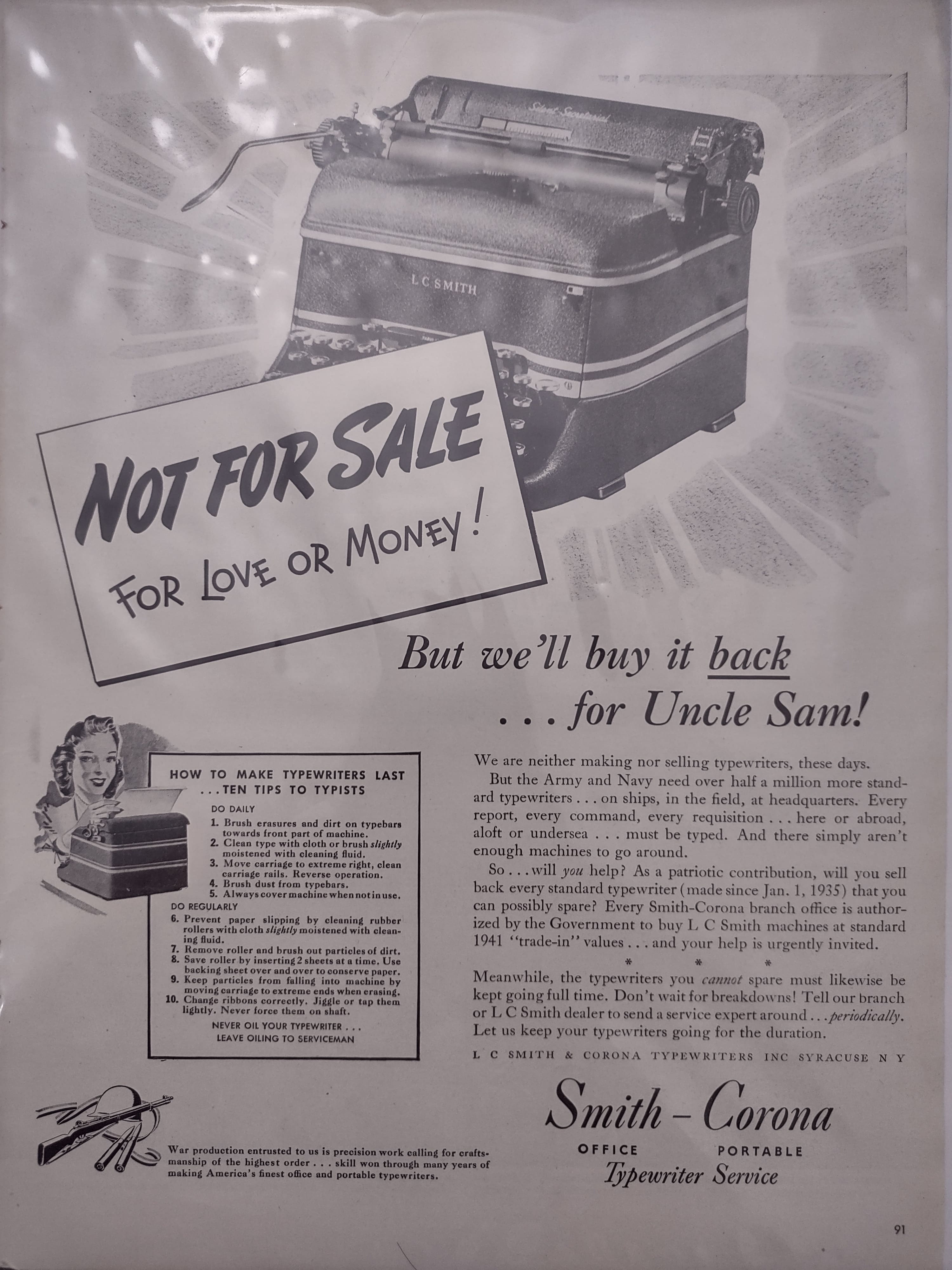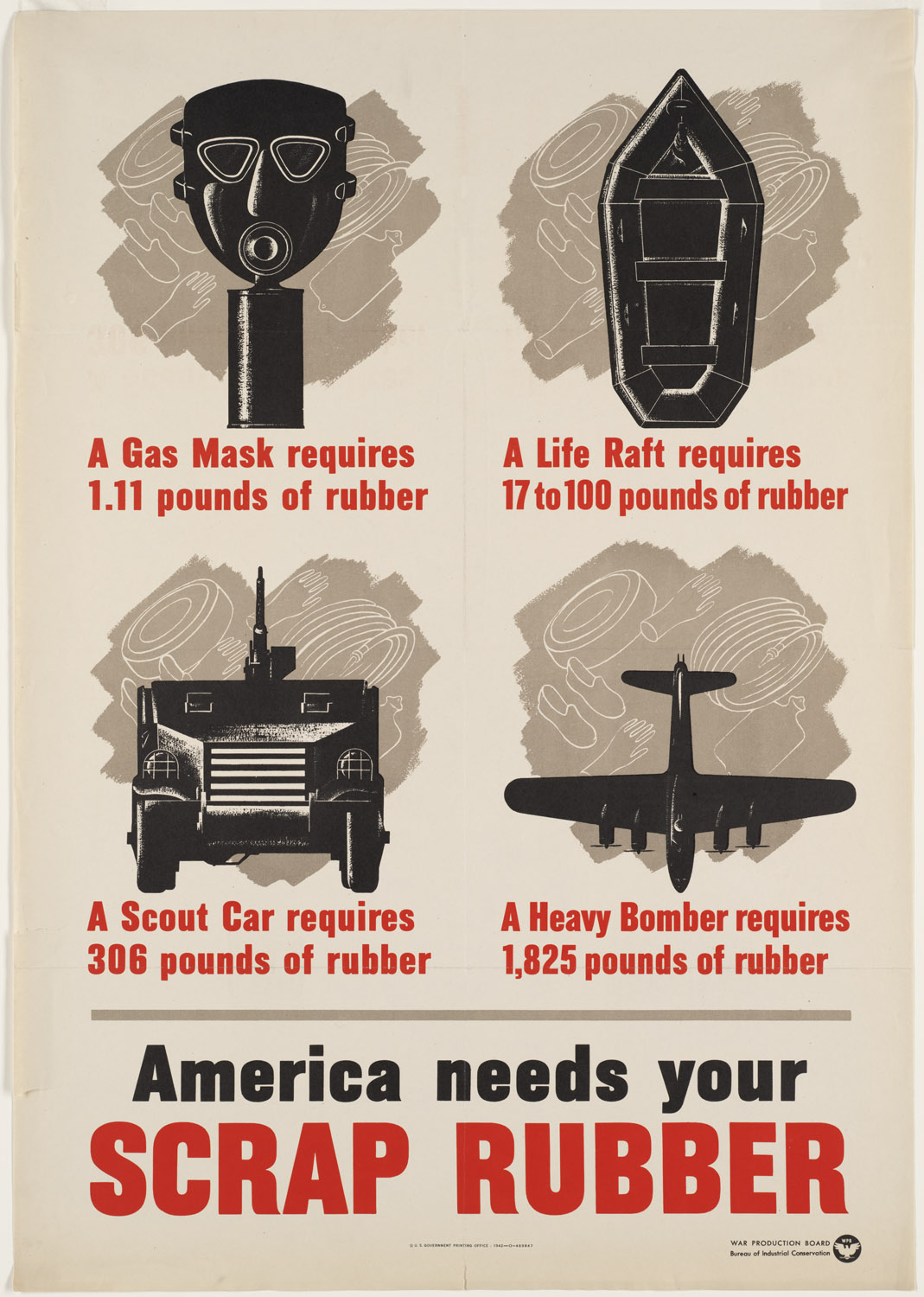We’ll buy back your Typewriter ... for Uncle Sam!
First Published: 02/10/24
The main matters on which all men deliberate and on which political speakers make speeches are some five in number: ways and means, war and peace, national defence, imports and exports, and legislation.
- Aristotle’s Rhetoric
My poster collection is becoming grander and more interesting! In the past, I've written blogs about some of the more obscure posters I've collected from my local bookstore, Reader's Corner. These blogs covered topics like one of the earliest flight simulators used during World War II and the Addressograph, a machine that automatically imprinted names, addresses, or other information on envelopes or forms, somewhat similar to what Xerox later offered.
The Poster
Today, we will explore the following poster:

The poster is about a Smith-Corona Typewriter Service offering to buy back typewriters for the U.S. government due to a typewriter shortage during the war. The poster's description states the following:
But we’ll buy it back ... for Uncle Sam!
We are neither making nor selling typewriters, these days. But the Army and Navy need over half a million more standard typewriters … on ships, in the field, at headquarters. Every report, every command, every requisition … here or abroad, aloft or undersea … must be typed. And there simply aren’t enough machines to go around.
So … will you help? As a patriotic contribution, will you sell back every standard typewriter (made since Jan. 1, 1935) that you can possibly spare? Every Smith-Corona branch office is authorized by the Government to buy LC Smith machines at standard 1941 “trade-in” values … and your help is urgently invited.
Meanwhile, the typewriters you cannot spare must likewise be kept going full time. Don’t wait for breakdowns! Tell our branch or LC Smith dealer to send a service expert around … periodically. Let us keep your typewriters going for the duration.
LC SMITH & CORONA TYPEWRITERS INC SYRACUSE NY
What's fascinating is that Smith-Corona is still in existence today. Wikipedia provides a great overview of how they have managed to adapt through more than a century of innovation:
Once a large U.S. typewriter and mechanical calculator manufacturer, Smith Corona expanded aggressively during the 1960s to become a broad-based industrial conglomerate with products extending to paints, foods, and paper. The mechanical calculator sector was wiped out in the early 1970s by the production of inexpensive electronic calculators, and the typewriter business collapsed in the mid-1980s due to the digital revolution and PC-based word processing.
Smith Corona adapted by manufacturing word processing typewriters such as the PWP 1400 model. Its competitors were Brother, Olivetti, Silver Seiko, Adler, Olympia and IBM. In late 2010, Smith Corona entered the industrial ribbon and label market.
The company no longer manufactures typewriters or calculators, but does manufacture large quantities of barcode and shipping labels and the thermal ribbons used in thermal transfer printers.
Origins
The years mentioned in the poster make it evident that the war being indirectly referenced is World War II. With a bit of scooby-dooing, I was able to narrow it down to Life magazine’s September 28, 1942 edition - page 91. This was one year before the Allied invasion of Italy, two years before the D-Day invasion, and three years before the end of World War II.
Commonly, during wars - and specifically in the U.S. during World War II - there was a significant pivot in industrial output from civilian to military production to support the Allied forces. Factories initially dedicated to consumer goods were repurposed to manufacture weapons, aircraft, and other military equipment. Furthermore, the war led to labor shortages, with millions of Americans enlisted in the military, significantly reducing the civilian workforce.
Interestingly, Smith-Corona wasn't the only typewriter service to run such advertisements. John Bush Jones discusses this incident in his book All-Out for Victory!: Magazine Advertising and the World War II Home Front.
Virtually all conservation ads in the leading general-interest magazines were aimed at civilian consumers. But there was also a small group that targeted the business community, all — with the exception of ads on how to keep one’s Mimeograph machine up and running — dealing with one particular article — typewriters. Some of these ads had a character, and an angle, all their own. During the war, America’s three leading typewriter manufacturers — Underwood, Smith-Corona, and Royal — were not, of course, manufacturing typewriters but were engaged in various kinds of war production. Accordingly, the ads of all three companies (very few by Underwood, incidentally) focused on how individuals and businesses could keep their typewriters in good working order so that they would hold up until new machines could be produced. But in the late summer and fall of 1942 a new dimension was added to the Royal and Smith-Corona ads typified by the words in Royal’s ad in Life on August 24, 1942, headed, “Brother can you spare a typewriter to help win the war?”: “We’re not selling Royal Typewriters today . . . WE’RE BUYING ’EM! The United States Government is in urgent need of 600,000 typewriters — for use by the Army … the Navy ... the Air Corps … the Marine Corps. These machines are needed for speeding up war production and the movement of supplies — transmitting orders to troops on land . . . ships at sea . . . even planes in the air. The typed message is the fastest, most reliable means of written communication! Typewriters are essential to Victory!” (103). This ad and the others by both Royal and Smith-Corona explained their buy-back scheme in which all standard (not portable) typewriters of their own manufacture made since January 1, 1935, would be purchased at their 1941 trade-in value regardless of the shape they were in, to be reconditioned and sent to the government for distribution to the armed forces. This program appears to be the only case of conserved, still usable equipment — not scrap — going directly into the business of fighting the war.
Digging a bit deeper, I found a booklet from August 1942, titled Rationing: Why and How, which was published by the Office of Price Administration (OPA). OPA was created by Roosevelt a year earlier on August 28, 1941, its purpose was to “place a ceiling on prices of most goods, and to limit consumption by rationing.” Here’s what the booklet said about the typewriter shortage:
Typewriters: Typewriter manufacturing plants were well suited for conversion to the production of rifle, pistol, and machine-gun parts, as well as other items essential to the war. This fact and war needs for the metals which normally go into typewriters resulted, early in 1942, in the curtailment of typewriter production and its complete stoppage a few months later. All new production since March has gone directly to the armed forces. Indeed the Government launched in July a program to buy half a million used machines for the Army and Navy. To assure that the needs of war contractors and other essential agencies are met, the Government has rationed typewriters.
Nonportable typewriters may be secured by firms which are primarily engaged in military construction or war production. Portables may be purchased by the same eligibles, and in addition, by Government agencies, newspapers, and radio stations, communications services, Red Cross, Office of Civilian Defense, and other essential war services.
Certificates to buy available typewriters may be secured upon application to the local War Price and Rationing Board.

What Followed?
By December, the stock situation seemed to be even more dire. So much so that on December 5, 1942, the then Price Administrator, Leon Henderson, acted to make additional typewriters available to the armed services from the country’s severely limited stocks. A press release from the Office of War Information, published in the Saturday morning papers, laid all of this out in much finer detail. It states that:
Explaining that manufacture of typewriters has been practically halted by the War Production Board and that the heavy demands of the Army and Navy must be filled from typewriters now in the hands of the trade and of users. Mr. Henderson put into immediate effect an amendment of OPA's typewriter rationing regulations which:
- Forbids the sale to civilians of all standard typewriters except obsolete models and “stripped” portables; and
- Restricts rentals of non-portable typewriters to those made before January 1, 1935.
Under the ruling (Amendment No. 7 to Ration Order 4), typewriter sales from today on may be made only to members of the trade and to the Procurement Division of the Treasury Department - the authorized agents for the Army, Navy, and other government agencies essential to the war effort - and to those persons authorized to buy typewriters for export. It is estimated that about 125,000 typewriters in the hands of dealers and manufacturers will be made available under today's amendment.
Persons now holding typewriter certificates are permitted to make purchases, providing they do so by January 1.
Anyway, the 1947 book Field Administration of Wartime Rationing by Emmette S. Redford mentions that consumer rationing of typewriters lasted until April 1944. This can be further corroborated by exploring an April 20, 1944 press release from the Office of Price Administration:
Used typewriters and new typewriters in the hands of dealers will not be rationed after April 22, 1944, the Office of Price Administration announced today. OPA officials emphasized that today's action does not affect distibution of new typewriters in the hands of manufacturers, which continue to be controlled by the War Production Board.
“Abandonment of typewriter rationing is in keeping with our general policy to relax rationing rules whenever the situation warrants it,” OPA Administrator Chester Bowles said. “An analysis of current trade inventories and the activity of local War Price and Rationing Boards in granting certificates for typewriter rentals, indicates that typewriter rationing is no longer necessary.
OPA's latest statistical report shows that, in 14 months, 4,052 certificates for rentals of typewriters have been granted, covering 15,177 machines. This amounts to about 10 per cent of all used machines, built since 1928, in the hands of the trade. Inventory reports also show that even where machines were released for unrestricted sale, many of them remained in dealers' stocks as a part of the used typewriter pool for rental purposes. A contributing factor to the favorable supply situation was a limited increase in new typewriter production, begun late last year, which is providing new machines for the most urgent civilian needs. The conclusion of the Government's program of acquiring used typewriters for the armed forces also eased the pressure of demand.
Conclusion
And that’s it, folks! Hope you had fun exploring this little blog post, a good ol' dance in the den. I’ll be back soon with more interesting posters. Until next time!
←